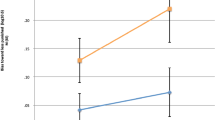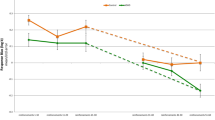Abstract
The associations between children's behavior and their performance on a task with a steadily increasing ratio of punished to rewarded responses was investigated in a group of clinic-referred (n= 92) and normal control (n= 40) children between the ages of 6 and 13. Clinic-referred children with an anxiety disorder played significantly fewer trials than clinic-referred children without an anxiety disorder but the response style of the anxious children did not differ from that of a normal control group. Children with severe conduct problems who had no anxiety disorder played more trials than (a) children with severe conduct problems and a comorbid anxiety disorder, (b) nonanxious children with attention-deficit hyperactivity disorder, and (c) children in the normal control group. The strongest evidence for the reward dominant response style was for nonanxious subjects with elevations on a measure of psychopathic features, irrespective of whether they also had conduct problems and irrespective of whether they were clinic-referred.
Similar content being viewed by others
References
Achenbach, T. M. (1991).Manual for the Child Behavior Checklist/4–18 and 1991 Profile. Burlington: University of Vermont, Department of Psychiatry.
American Psychiatric Association. (1987).Diagnostic and statistical manual for mental disorders (3rd ed., rev.). Washington, DC: Author.
Daugherty, T. K., & Quay, H. C. (1991). Response perseveration and delayed responding in childhood behavior disorders.Journal of Child Psychology and Psychiatry, 32, 453–461.
Edelbrock, C. S., Costello, A. J., Dulcan, M. K., Kalas, R., & Conover, N. C. (1985). Age differences in the reliability of psychiatric interview of the child.Child Development, 56, 265–275.
Fowles, D. C. (1988). Psychophysiology and psychopathology: A motivational approach.Psychophysiology, 25, 373–391.
Frick, P. J., & Hare, R. D. (in press).The Psychopathy Screening Device—PSD. Toronto: Multi-Health Systems.
Frick, P. J., & O'Brien, B. S. (1994). Conduct disorders. In R. T. Ammerman and M. Hersen (Eds.),Handbook of child behavior therapy in the psychiatric setting (pp. 199–216). New York: Wiley.
Frick, P. J., O'Brien, B. S., Wootton, J. M., & McBurnett, K. (1994). Psychopathy and conduct problems in children.Journal of Abnormal Psychology, 103, 700–707.
Gorenstein, E. E., & Newman, J. P. (1980). Disinhibitory psychopathology: A new perspective and a model for research.Psychological Review, 87, 301–315.
Gray, J. A. (1970). The psychophysiological basis of introversion-extraversion.Behavior Research and Therapy, 8, 249–266.
Gray, J. A. (1976). The neuropsychology of anxiety. In I. G. Sarason & C. D. Spielberger (Eds.),Stress and anxiety (Vol. 3, pp. 3–26). Washington, DC: Hemisphere.
Gray, J. A. (1982).The neuropsychology of anxiety: An enquiry into the functions of the septo-hippocampal system. Oxford, England: Oxford University Press.
Hare, R. D. (1991).The Hare Psychopathy Checklist—Revised. Toronto: Multi-Health Systems.
Hare, R. D., Hart, S. D., & Harpur, T. J. (1991). Psychopathy and the DSM-IV criteria for antisocial personality disorder.Journal of Abnormal Psychology, 100, 243–244.
Harpur, T. J., Hare, R. D., & Hakstian, A. R. (1989). Two-factor conceptualization of psychopathy: Construct validity and assessment implications.Psychological Assessment: A Journal of Consulting and Clinical Psychology, 1, 6–17.
Hinshaw, S. P. (1987). On the distinction between attentional deficits/hyperactivity and conduct problems/aggression in child psychopathology.Psychological Bulletin, 101, 443–463.
Kagan, J. (1966). Reflection-impulsivity: The generality and dynamics of conceptual tempo.Journal of Abnormal Psychology, 71, 17–24.
Lahey, B. B., Loeber, R., Quay, H. C., Frick, P. J., & Grimm, J. (1992). Oppositional defiant disorder and conduct disorders: Issues to be resolved for DSM-IV.Journal of the American Academy of Child and Adolescent Psychiatry, 31, 539–546.
McBurnett, K., Lahey, B. B., Frick, P. J., Risch, C., Loeber, R., Hart, E. L., Christ, M. A. G., & Hanson, K. S. (1991). Anxiety, inhibition, and conduct disorder in children: II. Relation to salivary cortisol.Journal of the American Academy of Child and Adolescent Psychiatry, 30, 192–196.
Newman, J. P., & Kosson, D. S. (1986). Passive avoidance learning in psychopathic and nonpsychopathic offenders.Journal of Abnormal Psychology, 95, 252–256.
Newman, J. P., Patterson, C. M., & Kosson, D. S. (1987). Response perseveration in psychopaths.Journal of Abnormal Psychology, 96, 145–148.
Newman, J. P., & Wallace, J. F. (1993). Diverse pathways to deficient self-regulation: Implications for disinhibitory psychopathology in children.Clinical Psychology Review, 13, 688–720.
Newman, J. P., Widom, C. S., & Nathan, S. (1985). Passive avoidance syndromes of disinhibition: Psychopathy and extraversion.Journal of Personality and Social Psychology, 48, 1316–1327.
O'Brien, B. S., Frick, P. J., & Lyman, R. D. (1994). Reward dominance among children with disruptive behavior disorders.Journal of Psychopathology and Behavioral Assessment, 16, 131–145.
Piacentini, J. C., Cohen, P., & Cohen, J. (1992). Combining discrepant diagnostic information from multiple sources: Are complex algorithms better than simple ones?Journal of Abnormal Psychology, 20, 51–64.
Quay, H. C., & Peterson, D. R. (1983).Interim manual for the Revised Behavior Problem Checklist. Coral Gables, FL: University of Miami, Applied Social Sciences.
Raine, A. (1993).The psychopathology of crime: Criminal behavior as a clinical disorder. New York: Academic Press.
Russo, M. F., & Beidel, D. C. (1993). Comorbidity of childhood anxiety and externalizing disorders: Prevalence, associated characteristics, and validation issues.Clinical Psychology Review, 14, 199–221.
Scerbo, A., Raine, A., O'Brien, M., Chan, C. Rhee, C., & Smiley, N. (1990). Reward dominance and passive avoidance learning in adolescent psychopaths.Journal of Abnormal Child Psychology, 18, 451–463.
Shaffer, D., Fisher, P., Piacentini, J., Schwab-Stone, M., & Wicks, J. (1992).NIMH Diagnostic Interview Schedule for Children, Version 2.3. New York: Columbia University.
Shapiro, S. K., Quay, H. C., Hogan, A. E., & Schwartz, K. P. (1988). Response perseveration and delayed responding in undersocialized aggressive conduct disorder.Journal of Abnormal Psychology, 97, 371–373.
Spitzer, R. L., Davies, M., Barkley, R., & Costello, A. (1990). The DSM-III-R field trials for the disruptive behavior disorders.Journal of the American Academy of Child and Adolescent Psychiatry, 29, 690–697.
Sutker, P. B., Bugg, F., & West, J. A. (1993). Antisocial personality disorder. In P. B. Sutker & H. E. Adams (Eds.),Comprehensive handbook of psychopathology (2nd ed., pp. 337–370). New York: Plenum Press.
Walker, J. L., Lahey, B. B., Russo, M. F., Frick, P. J., Christ, M. A., McBurnett, K., Loeber, R., Stouthamer-Loeber, M., & Green, S. M. (1991). Anxiety, inhibition, and conduct disorder in children: I. Relations to social impairment.Journal of the American Academy of Child and Adolescent Psychiatry, 30, 187–191.
Wechsler, D. (1974).Manual for the Wechsler Intelligence Scale for Children—Revised. New York: The Psychological Corporation.
Woolston, J. L., Rosenthal, S. L., Riddle, M. A., Sparrow, R. S., Cicchetti, D., & Zimmerman, L. D. (1989). Childhood comorbidity of anxiety/affective disorders and behavior disorders.Journal of the American Academy of Child and Adolescent Psychiatry, 28, 707–713.
Author information
Authors and Affiliations
Additional information
We would like to thank the staff of the Alabama School-Aged Assessment Service and the Tuscaloosa County School System for their help in data collection. We would like to especially acknowledge the help of John Gurley in data collection.
Rights and permissions
About this article
Cite this article
O'Brien, B.S., Frick, P.J. Reward dominance: Associations with anxiety, conduct problems, and psychopathy in children. J Abnorm Child Psychol 24, 223–240 (1996). https://doi.org/10.1007/BF01441486
Received:
Issue Date:
DOI: https://doi.org/10.1007/BF01441486




